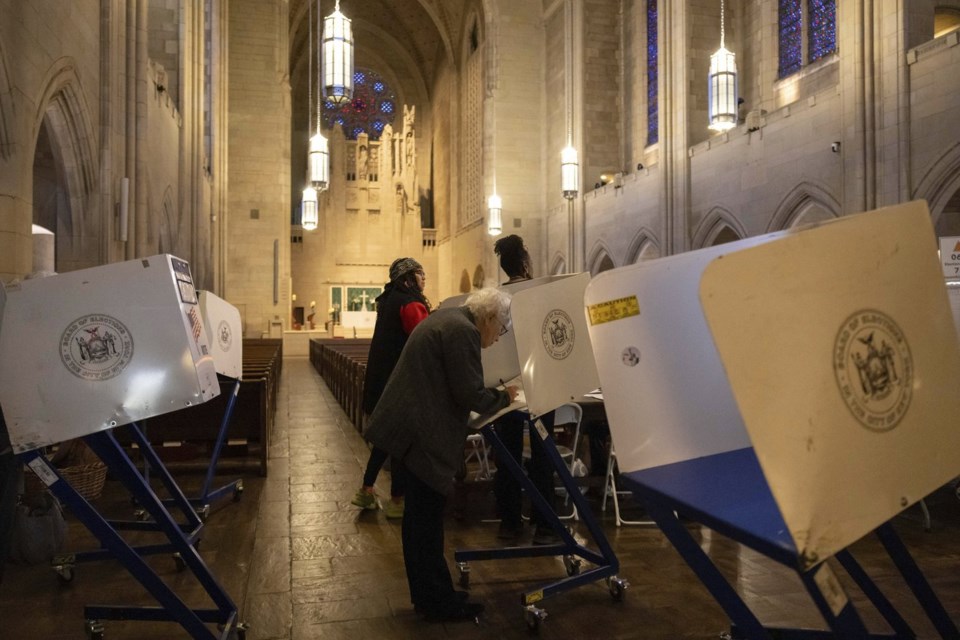NEW YORK (AP) — New York City is using in its a system that takes some explaining, even for people who have used it before.
Ranked choice is based on a simple premise: Democracy works better if people aren't forced to make an all-or-nothing choice with their vote.
Rather than pick just one candidate, voters get to rank several in order of preference. Even if a voter's top choice doesn't have enough support to win, their rankings of other candidates still play a role in determining the victor.
The system is more complex than a traditional election, making it tough to forecast a winner. It could also take longer to get results.
How does it work?
, voters get to rank up to five candidates, from first to last, on the ballot.
If one candidate is the first choice of a majority of voters — more than 50% — that person wins the race outright, just like in a traditional election.
If nobody hits that threshold, ranked choice analysis kicks in.
Vote tabulation is done by computer in rounds. After the first round, the candidate in last place — the candidate ranked No. 1 by the fewest amount of people — is eliminated. The computer then looks at the ballots cast by people who ranked that candidate first, to see who they ranked second. Those people's votes are then redistributed to their second choices.
That process then repeats. As more candidates are eliminated, voters' third, fourth and even fifth choices could potentially come into play. Rounds continue until there are only two candidates left. The one with the most votes wins.
How long will this take?
The computerized process of tabulating votes takes little time, but it doesn't start right away.
Polls closed at 9 p.m. Tuesday. The ranked choice tabulations, however, won't start until July 1 because the city needs to wait for the arrival of mail-in ballots.
The July 1 tabulation could confirm a victory for Zohran Mamdani, who had a commanding lead over former New York Gov. Andrew Cuomo on election night, but the result won't be official. Further rounds of ranked choice analysis will be done as additional absentee ballots come in until the board certifies the election July 15.
This was the second time New York City has used ranked choice in a mayoral primary. The first time, in 2021, when elections officials neglected to clear test data from the tabulation program. That led to an inaccurate vote tally being reported until officials realized the error.
Why do people like ranked choice?
One benefit is that nobody “wastes” their vote by picking an unpopular candidate as their first choice.
Voters can rank someone they like No. 1, even if they suspect the candidate doesn't stand a chance. If that person is eliminated, voters still get a say in who wins based on their other rankings.
Another benefit is that it's tough for someone to get elected without broad support. In a traditional election, it's possible for someone with fringe political views to win in a crowded field of candidates, even if they are deeply disliked by a majority of voters.
That's theoretically less likely in a ranked choice system. A candidate could get the largest share of first-choice votes but still lose to someone who is the second or third choice of a large number of people.
What are the negatives?
The system is tough to grasp. It requires voters to do more research. It also makes races less predictable.
Trust could also be a potential problem. Ordinarily, candidates, the public and news organizations have a easy time knowing who is leading a race as the vote starts to roll in.
Under the ranked choice system, what you see on election night isn't necessarily the way the race is going to turn out.
That’s a challenge for news organizations, like The Associated Press, that analyze vote tallies and attempt to report a winner before the count is complete.
There may be instances when candidates who seem to have a comfortable lead in first-place votes on election night lose because relatively few voters rank them as their second or third choice. That could lead to people questioning the results, including whether the process of redistributing votes has been done accurately by computer.
David B. Caruso, The Associated Press


